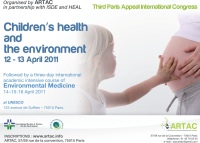- you are on : Environmental Medicine
- The environmental paradigm in medicine
The environmental paradigm in medicine
Infection and allergy aside, contemporary medicine utterly neglects the causes of diseases and afflictions, to treat & focus only on their bio-clinical effects downstream from their origin; so as to determine the diagnosis, prognosis and treatment (not efficient upstream prevention). According to environmental paradigm, only primary prevention measures aimed at reducing environmental causes of disease from their sources, and at protecting all individuals from any dangerous exposure, can reverse our current public health plagues. They rely on society and thus may be subject to conflicting interests and therefore opposing political power. Environmental medicine’s objectives are also precisely the concern of environmental health. But the targets of environmental medicine are narrower, as its basic principles rely on the diagnosis of environmental disease, the treatment of patients who are victims of pollution and the setting-up of measures of individual environmental protection.
For now, this medicine essentially concerns new diseases and afflictions with proved or suspected environmental origin, such as intolerance to electromagnetic fields and chemicals, or syndromes that have appeared and been described recently (e.g. Autism spectrum disorders). In fact, thanks to research and new breakthroughs, soon environmental medicine will concern just about all medical pathology, including many chronic long-known diseases such as cancer, obesity, type 2 diabetes mellitus, asthma, many neurodegenerative disorders such as Parkinson’s and Alzheimer’s diseases. But, as indicated in adjoining the chart, this new approach must respect the limits set by the acquisition of scientific knowledge.
Classification of diseases and afflictions whose environmental origin is very likely, probable or possible.
Environment is here used in its restricted meaning, ie not taking into account tobacco addiction or other risk factors related to lifestyle; rather physical, chemical or biological degradation in the environment related to collective social activities.
| 1. Diseases and afflictions with a very likely environmental origin |
|
| 2. Diseases and afflictions with a probable environmental origin |
|
| 3. Diseases and afflictions with a possible environmental origin |
|
As Pr Jean Bernard, a great French hematologist, hypothesized, the main target of medicine should be preventive and predictive, before looking to at curing. Using tuberculosis as an example, Jean Bernard often reminded medical doctors that efficient prevention, prediction, and even treatment are made possible only by determining causes, and that knowledge has a positive impact on not just patients but to society, increasing economic efficiency and reducing epidemics. Before Robert Koch discovered the famous Mycobacterium tuberculosis, medical practice was devoted to a purely formal and mechanical hypothetical view of the disease. Not only did that prevent curing patients despite prolonged stays in sanatoriums, but it was very expensive for society due to the ineffectiveness of care, cumbersome means implemented and especially due to the spread of the infection. Koch’s discovery opened the door to sanitary measures, vaccination and later on the development of effective antituberculosis drugs; and therefore it revolutionized phtysiology, but also drastically cut back on costs by eradicating the epidemic.
However, what was true during the last century is unfortunately no longer true for diseases and afflictions today, as many infections are not the same – being viral, they are much more difficult to treat – and more importantly since most of diseases and afflictions today have physico-chemical causes, primary prevention measures to be taken unfortunately do not fall within the specific competence of medicine, rather they fall in the broader competence of political decision-makers and society at large.
